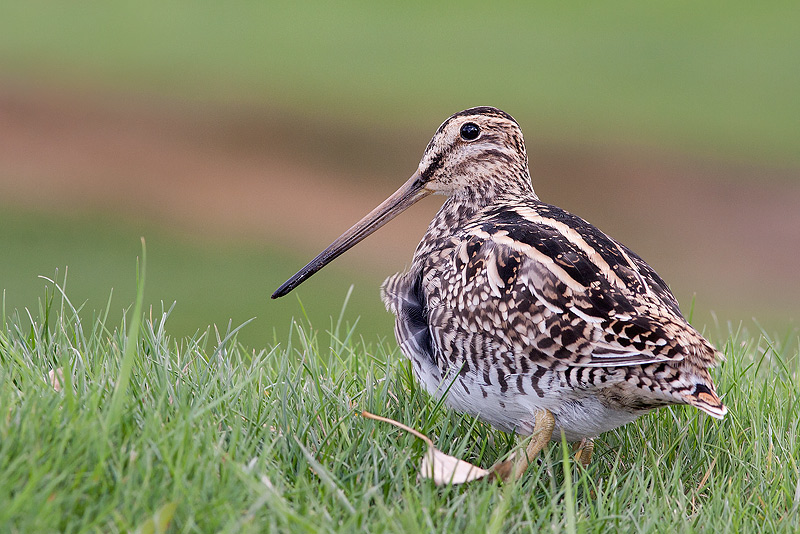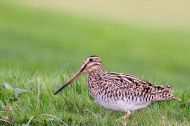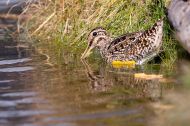Common Snipe
Becacina Común
Gallinago gallinago
Length: 320mm. Sexes alike. Bill greenish on basal half and dark brown on apical half; iris dark brown; head, neck and breast buff with dark brown spots and streaks; flanks whitish buff with wavy dark brown barring; abdomen white, sides of abdomen and undertail coverts cinnamon buff with dark brown bars. Back and scapulars blackish brown and chestnut with cryptic whitish buff and cinnamon patterns; lower back, rump and uppertail coverts cinnamon with dark brown spots; central rectrices reddish cinnamon and black to base, narrow black subterminal band and whitish terminal band; lateral tail feathers whitish with fine dark brown barring. Wing coverts brownish grey with whitish and buffy margins and spots; secondary remiges dark brown with cinnamon bands and margins; primaries, alula and greater coverts of primaries dark greyish brown; axillaries whitish with dark brown barring. Legs olivaceous. Habitat and behaviour: this bird frequents grassy swamps and marshes, riverbanks, lakeshores and ponds, preferably those with a muddy bottom and covered with herbaceous vegetation; also peat bogs in the highlands; mostly solitary or in loosely scattered groups which are seen whenever they are flushed. Due to its mimetic coloration and habit of remaining crouched in the vegetation, it is difficult to sight; it springs into the air explosively when disturbed by man; its flight is swift and straight for a short distance and then becomes zigzagging.
The Common Snipe is active either during the day or night; to feed it wades in very shallow waters or moves in the mud and swamps, preying on all kinds of small invertebrates that occur in these habitats.
During the breeding season it flies high and every now and then turns and dives down at a steep angle, tail spread and wings quivering to make a “drumming” sound; this display is carried out in succession during the night or during heavy rains that occur in daylight.
It nests very early in August within the herbaceous vegetation; the nest is well hidden and made of grasses; females lay up to three olive buff eggs with blackish and violaceous spots; chicks are born with a black down with reddish and whitish flecks. Range: it is distributed countrywide; the race Gallinago gallinago paraguaiæ occurs from the north of Argentina to Buenos Aires, La Pampa and Mendoza; in Patagonia the race Gallinago gallinago magellanica occurs from Neuquén and Río Negro to Tierra del Fuego and Islas Malvinas. The latter migrates northwards during the autumn.
Illustrated Handbook of the Birds of Patagonia
Kindness: Kovacs Family |











